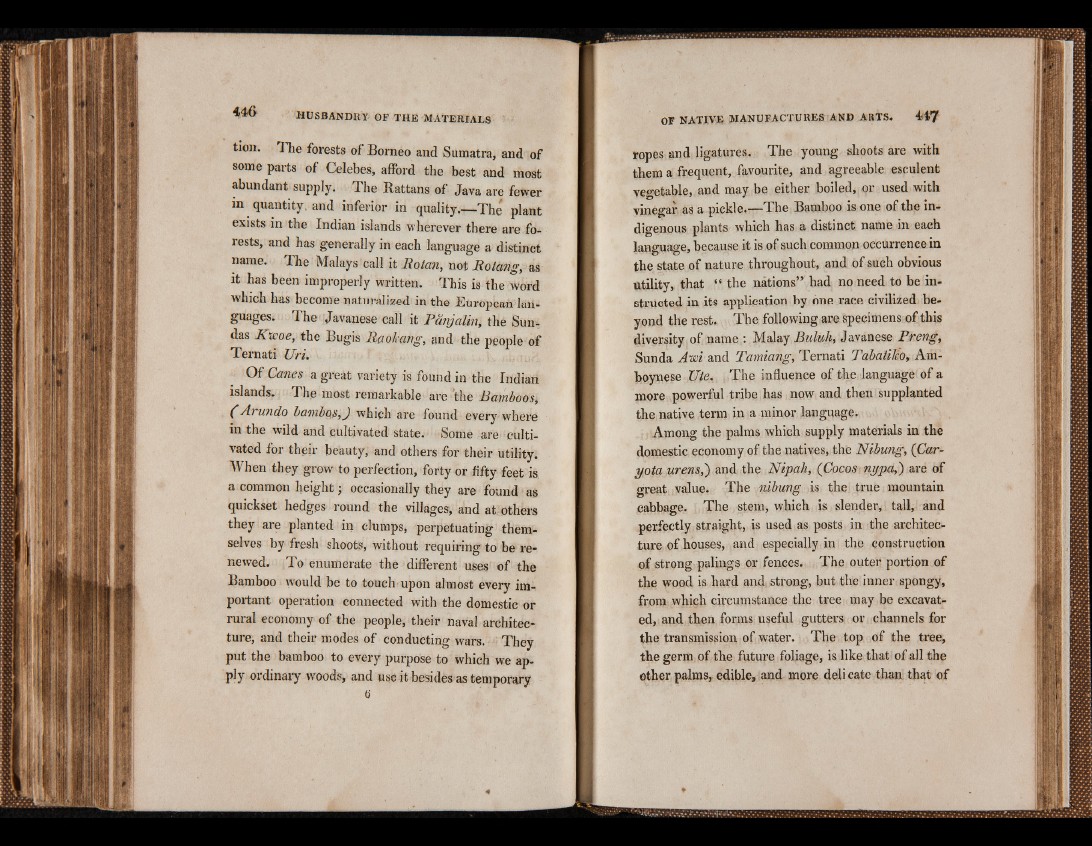
tion. The forests of Borneo and Sumatra, and of
some parts of Celebes, afford the best and most
abundant supply. The Rattans of Java are fewer
m quantity, and inferior in quality.—The plant
exists in the Indian islands wherever there are forests,
and has generally in each language a distinct
name. The Malays call it Rotan, not Rotang, as
it has been improperly written. This is the word
which has become naturalized in the European languages.
The Javanese call it Panjalin, the Sun-
das Kwoe, the Bugis Raokang, and the people of
Ternati Uri.
Of Canes a great variety is found in the Indian
islands. The most remarkable are the Bamboos,
( Avundo bambos,J which are found every where
m the wild and cultivated state. Some are cultivated
for their beauty, and others for their utility.
When they grow to perfection, forty or fifty feet is
a common height; occasionally they are found as
quickset hedges round the villages, and at others
they are planted in clumps, perpetuating themselves
by fresh shoots, without requiring to be renewed.
To enumerate the different uses of the
Bamboo would be to touch upon almost every important
operation connected with the domestic or
rural economy of the people, their naval architecture,
and their modes of conducting wars. They
put the bamboo to every purpose to which we apply
ordinary woods, and use it besides as temporary
6
ropes and ligatures. The young shoots are with
them a frequent, favourite, and agreeable esculent
vegetable, and may be either boiled, or used with
vinegar: as a pickle.—The Bamboo is one of the indigenous
plants which has a distinct name in each
language, because it is of such common occurrence in
the state of nature throughout, and of such obvious
utility, that “ the nations” had no need to be instructed
in its application by one race civilized beyond
the rest. The following are specimens of this
diversity of name : Malay Buluh, Javanese Preng,
Sunda Am and Tamiang, Ternati Tabatil/o, Am-
boynese XJte. The influence of the language of a
more powerful tribe has now and tben supplanted
the native term in a minor language.
Among the palms which supply materials in the
domestic economy of the natives, the Nibung, (Car-
yota urens,') and the Nipah, (Cocos nypa,) are of
o-reat value. The nibung is the true mountain
cabbage. The stem, which is slender, tall, and
perfectly straight, is used as posts in the architecture
of houses, and especially in the construction
of strong palings or fences. The outer portion of
the wood is hard and. strong, but the inner spongy,
from which circumstance the tree may be excavated,
and then forms useful gutters; or channels for
the transmission of water. The top of the tree,
the germ of the future foliage, is like that of all the
other palms, edible, and more deli cate than that of